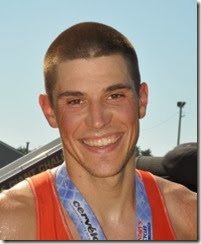 Last week I posted some video of my friend Sam Winebaum’s running form after a filming session at the clinic. Today I wanted to share some video of another athlete who visited last week: Colin Cook. Colin owns Peak Triathlon Coaching in Bedford, New Hampshire, and is an accomplished triathlete. As evidence of his ability, he won the 30-34 age group at the 2013 Ironman North American Championship at Mont-Tremblant, and recently finished the Ironman World Championship at Kona in 9:37:45.
Last week I posted some video of my friend Sam Winebaum’s running form after a filming session at the clinic. Today I wanted to share some video of another athlete who visited last week: Colin Cook. Colin owns Peak Triathlon Coaching in Bedford, New Hampshire, and is an accomplished triathlete. As evidence of his ability, he won the 30-34 age group at the 2013 Ironman North American Championship at Mont-Tremblant, and recently finished the Ironman World Championship at Kona in 9:37:45.
Colin’s gait footage is interesting because he brought three radically different shoes to the clinic on filming day – a pair of Hokas, a pair of more traditional K-Swiss trainers, and a pair of ultraminimal Vivobarefoot Evos. Colin likes to mix up footwear since he feels it varies the stress applied to the body (an approach I practice myself). He did the run at Kona in the Hokas and loves them, but he still also runs a bit in the more minimal Vivos. Colin doesn’t have a significant lower extremity injury history, so we weren’t trying to fix anything. He’d simply never had his gait filmed before.
Let’s take a look at Colin’s Videos. The first shows his form in side view in the three shoes (Hoka, K-Swiss, Vivobarefoot, in that order):
What’s cool about this video is how remarkably similar his form is in shoes so drastically different as the Hokas and Vivobarefoot Evos. One is maximally cushioned, the other minimally, Colin’s contact pattern is almost identical across the board:
My suspicion is that some people are more sensitive to changes in footwear than others, and Colin has a pretty consistent gait pattern. He also has a decent amount of knee bend at contact and a fairly vertical shin (not much overstride), so he may be running with a stride that doesn’t exhibit a great deal of impact (if he were a significant overstrider in the Hokas I‘d guess his form would look more different in the Evos). He also tends to scuff with his heel at contact rather than coming straight down, and this may allow him to run in the Evos with a mild heel strike. His posture is nice and upright with a slight forward lean. Very nice overall in the side view.
Just for fun, here’s a closeup video of a Hoka footstrike:
The next video is a sequence of the same shoes from behind, focusing in on the feet:
Once again, not a huge amount of difference between the shoes. If anything, the Hokas maybe look a bit more stable than the other two (possibly a consequence of the bucket sole design and wide sole base).
Finally, here are wider shots from the front and back allowing full body visualization:
One of the challenges with gait analysis is that it’s easy to pick out things that look different, but you also have to recognize that everyone moves a little bit differently. Additionally, you need to consider whether the runner is currently injured or not, since sometimes gait patterns you observe are compensations for injury and not necessarily a contributor to an injury. In Colin’s case we have someone who is not injured, and who does not have a significant lower extremity injury history. He’s also performing at a very high level. As such, I’d be very hesitant to suggest any changes to his form, and I try to resist the temptation to overanalyze.
For the most part, I’d say Colin’s form looks great. If there is one thing that gives me a slight bit of concern it’s the fact that he has a lot of thigh adduction during stance. Translated from anatomy-speak into English, this simply means that his thigh angles inward and he has very little space between his knees during swing through. That being said, his shoulders stay pretty level in front and rear views, and I don’t detect a lot of hip drop (should have had him tuck in his shirt). This is a situation where I would leave things alone as I’ve seen cases a lot worse and he doesn’t have a history of injury. However, if problems ever developed at the knee or medial shin this is one thing to possibly have a deeper look at.
It’s always interesting to see how different people move, and Colin is an example of someone who I’d say has very nice form. If you have anything to add, feel free to fire away in the comments!


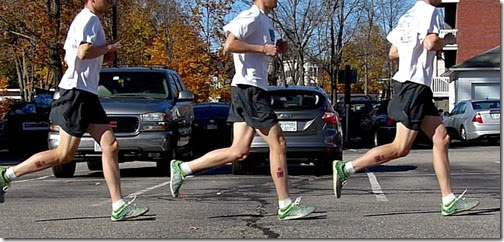
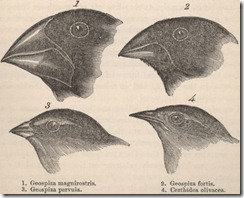
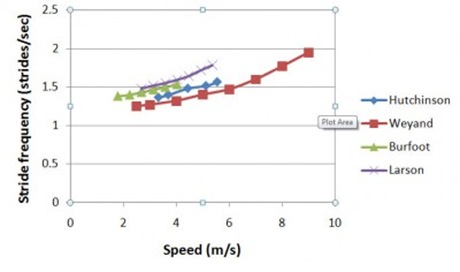
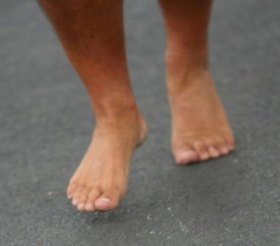
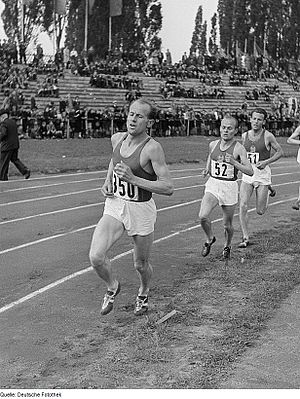















I really wish I had someone in town to get some vids/photos of my stride, lol
Do you have an iphone 5s? It can shoot 120fps.
Nope…Droid Boinic.
Best I have is an old Flip (60fps tops).
There are a few android phones that do 120, can’t recall which
Sent from my iPad
Sadly, mine is not one of them.
No worries, as I’d still need someone to tell me what to do once I could get video, lol
I can help with that part :) next phone upgrade!
Sent from my iPad
I’ll try to set up the Flip sometime and try it out.
What are your thoughts on the amount of knee lift? Reason I ask is when I had a gait analysis they suggested this to be an issue for me – but I think mine is similiar to Colins. I think the issue was that it was a sprinter looking at my running style.
I think it probably depends somewhat on speed. There was actually just a study that came out suggesting that higher knee lift is related to reduced impact. Need to read the full text. Colin was not running at race pace here so not to concerned, his stride is pretty solid among the many I have watched.
Sent from my iPad
This is all starting to make me very self-conscious.
You should see the reactions I sometimes get in the office when showing people their videos! Especially the rear view…
Sent from my iPad
Well see, here’s one of those slightly knock-kneed people that I would think might get injured, but perhaps since his hips remain stable he avoids getting hurt. Sometimes the insides of my knees touch a bit when I’m running. I don’t think my q angle is the most optimal, but I don’t think my hips drop. Maybe I should get a gait analysis. Fuck that… Just gonna keep going by feel and common sense until the wheels come off. So far so good. Looking forward to an hour in the Adios Boost tomorrow.
Glad I’m not the only one who noticed that his knees seem to come together a lot as his thigh turns in during leg swing.
9:37:45 at Kona is awesome, congratulations! I saw an article and video earlier this year that I re- found just now that compares different running styles used by triathletes. link to ttbikefit.com….
Colin seems to have naturally found what is very efficient for him coming off the bike.
That’s pretty cool. I had a suspicion that it was more about the runner and not so much about the shoes. This is just one more source that confirms it. Thanks for sharing this!
I think it can be both, each case is a bit different. It could be that Colin’s form has already adapted since he has been running some in minimal shoes for awhile. My guess is my results would be pretty similar, but if I had done the filming 5 years ago things would be different.
—-
Pete Larson’s Web Links:
-Performance Health Spine and Sport Therapy<http: about-us=”” dr-peter-larson=”” performancehealthnh.com=””>
-My book: Tread Lightly: link to ow.ly
-Blog: https://runblogger.com
-Twitter: link to twitter.com
-Facebook Page: link to facebook.com…
-Discussion Forum: https://runblogger.com/forum</http:>
Sub-10 in Kona–glad Colin’s not in my age group!
Colin’s shoe experience makes sense to me. Our experience is that experienced runners that are not fatigued are not effected by drastic shoe changes as much as inexperienced, injured, or fatigued runners.
What do you make of the continued internal rotation of the tibia after take of – left more so than right as sen by both feet rotating in after push off? Seems to me his glutes are unable to control the internal rotation force that comes with landing and he is losing a source of power upon push off?
As a forefoot striker with a stress fracture on my record, who recently started running altogether, I’d be curious about being critiqued.
Which bone did you fracture?
—-
Pete Larson’s Web Links:
-Performance Health Spine and Sport Therapy<http: about-us=”” dr-peter-larson=”” performancehealthnh.com=””>
-My book: Tread Lightly: link to ow.ly
-Blog: https://runblogger.com
-Twitter: link to twitter.com
-Facebook Page: link to facebook.com…
-Discussion Forum: https://runblogger.com/forum</http:>
basically the ball of my foot. I think it was sesamoid bone(s) if I remember correctly
Behind the big toe? Sesamoid or metatarsal?
—-
Pete Larson’s Web Links:
-Performance Health Spine and Sport Therapy<http: about-us=”” dr-peter-larson=”” performancehealthnh.com=””>
-My book: Tread Lightly: link to ow.ly
-Blog: https://runblogger.com
-Twitter: link to twitter.com
-Facebook Page: link to facebook.com…
-Discussion Forum: https://runblogger.com/forum</http:>
it was a small bone so it would be the sesamoid
Enjoyed reading this post as I’m always curious on the shoes ability to alter a runner’s gait. I notice that Colin looks like he has a mild heel strike – even at a high level of performance that doesn’t change anything? (i.e. prone to injuries, speed, etc.). Asking this question as a current heel striker.
I would classify his heel strike as mild, and with the way the rest of his stride looks I wouldn’t change a thing. I’m not aware of much in the way of conclusive evidence pointing to a change in foot strike bringing along performance gains for a guy at his level.
—-
Pete Larson’s Web Links:
-Performance Health Spine and Sport Therapy<http: about-us=”” dr-peter-larson=”” performancehealthnh.com=””>
-My book: Tread Lightly: link to ow.ly
-Blog: https://runblogger.com
-Twitter: link to twitter.com
-Facebook Page: link to facebook.com…
-Discussion Forum: https://runblogger.com/forum</http:>
I have recently just changed over to the hoka’s. They are the best shoes I have ever run in. I have done a couple of ultras, tri’s and marathons with no problems.